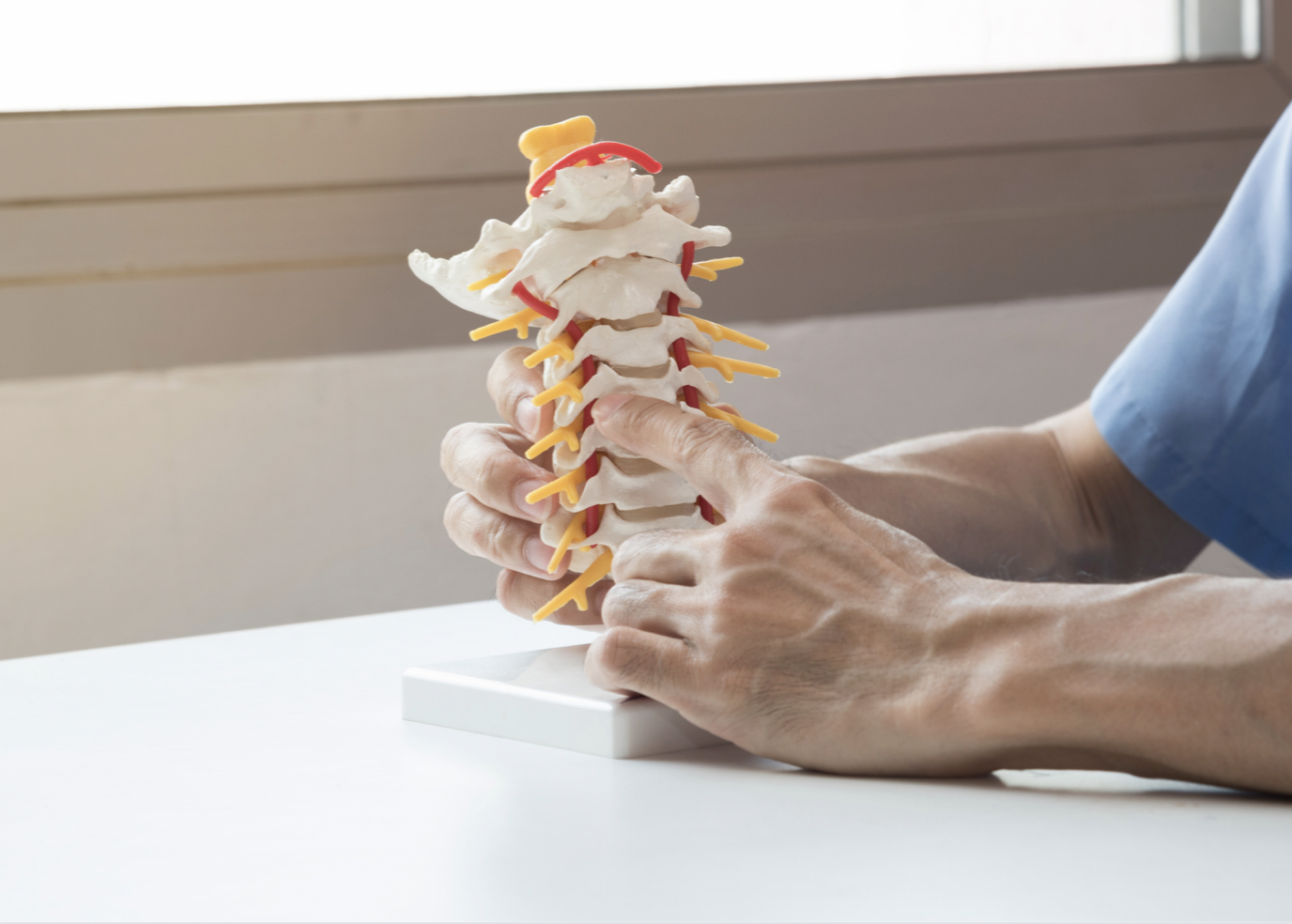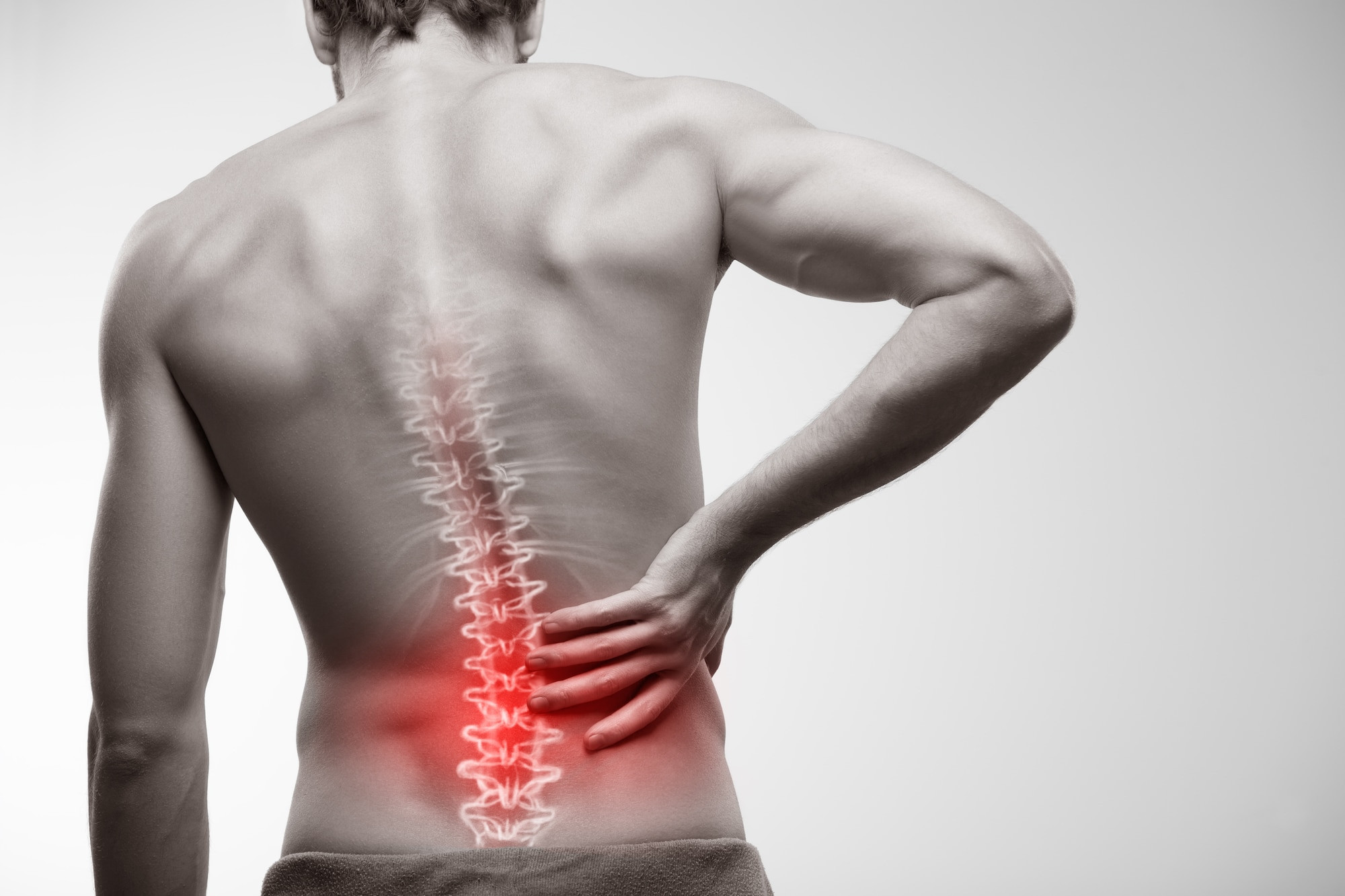Definisi
Spondilolisthesis merupakan pergeseran pada tulang belakang bagian bawah yang menyebabkan nyeri punggung. Pergeseran tersebut terjadi ke depan sehingga terjadi perubahan susunan tulang belakang. Spondilolisthesis berasal dari kata Yunani spondylos yang berarti “tulang belakang” dan listhesis yang berarti “bergeser, bergerak”. Seperti namanya, spondilolisthesis berkaitan erat dengan stabilitas tulang belakang. Pergerakan dari tulang belakang yang tidak seharusnya ini menyebabkan penekanan pada saraf yang menyebabkan nyeri punggung bawah dan nyeri pada tungkai.
Kata lain yang sering disalah artikan sebagai spondilolisthesis adalah spondilolisis. Keduanya dapat menyebabkan nyeri punggung bawah, namun dua kata tersebut menggambarkan kondisi yang berbeda.
- Spondilolisis menggambarkan kondisi fraktur atau patah tulang belakang, sedangkan
- Spondilolisthesis menggambarkan kondisi pergeseran tulang belakang ke arah depan (lebih di depan dibandingkan tulang belakang di bawahnya).
Spondilolsithesis dialami oleh 4–6% orang dewasa. Seseorang dapat hidup dengan spondilolisthesis selama bertahun-tahun tanpa menyadarinya. Spondilolisthesis degeneratif (atau yang disebabkan oleh penuaan) lebih sering terjadi pada usia di atas 50 tahun dan lebih sering terjadi pada wanita dibandingkan pria. Spondilolisthesis yang terjadi pada remaja dan dewasa muda disebut dengan isthmic spondylolisthesis yang didahului oleh spondilolisis. Spondilolisis yang tidak ditangani dengan baik dapat menyebabkan spondilolistesis, terutama jika penyebab patah tulang merupakan tekanan yang bersifat stress fracture.
Penyebab
Berdasarkan jenis dan penyebabnya, terdapat tiga jenis spondilolisthesis, antara lain:
- Spondilolisthesis kongenital, yaitu spondilolisthesis yang terjadi ketika di dalam kandungan. Hal ini terjadi ketika tulang belakang tidak tersusun sebagaimana mestinya dan dapat meningkatkan risiko mengalami spondilolisthesis di masa tua.
- Spondilolistesis ismus (isthmic spondylolisthesis) adalah spondilolisthesis yang terjadi setelah spondilolisis. Patah tulang dapat membuat susunan tulang belakang menjadi lebih rapuh dan dapat bergerak bebas.
- Spondilolisis degeneratif, merupakan jenis yang paling sering terjadi. Kondisi ini merupakan kondisi degeneratif (penuaan), ketika bantalan antara tulang belakang dan sendi tidak lagi optimal.
Tipe spondilolisthesis yang lebih jarang terjadi, antara lain:
- Spondilolisthesis traumatik, disebabkan oleh trauma atau kecelakaan yang menggeser susunan tulang belakang
- Spondilolisthesis patologis, yaitu spondilolisthesis yang disebabkan oleh kondisi medis lainnya, seperti osteoporosis atau tumor
- Spondilolisthesis pascaoperasi, yaitu spondilolisthesis yang disebabkan oleh operasi tulang belakang
Faktor Risiko
Beberapa faktor yang meningkatkan risiko mengalami spondilolisthesis antara lain:
- Atlet. Atlet muda yang melakukan olahraga yang melibatkan tulang belakang sisi lumbal (sisi bawah) seperti gimnastik dan sepak bola memiliki risiko lebih tinggi mengalami spondilolisthesis. Pergeseran tulang belakang ini lebih sering terjadi ketika anak sedang pubertas atau mengalami percepatan pertumbuhan (growth spurt). Spondilolisthesis merupakan penyebab nyeri punggung tersering pada anak dan remaja.
- Genetik. Beberapa orang memiliki kerentanan genetik terhadap spondilolisthesis ismus dan lahir dengan bagian tulang belakang yang lebih tipis. Bagian yang tipis ini menghubungkan dua sendi tulang belakang. Karena tipis, daerah sambungan ini lebih mudah untuk mengalami patah dan menyebabkan spondilolisthesis. Spondilolisthesis generatif memiliki kontribusi genetik yang besar.
- Usia. Dengan bertambahnya usia, akan terjadi kerusakan pada tulang belakang sehingga menjadi lemah dibandingkan ketika muda.
Gejala
Anda dapat memiliki spondilolisthesis tanpa mengalami gejala-gejala di bawah ini. Jika Anda memiliki gejala, gejala utama yang dirasakan adalah nyeri punggung bawah yang menjalar ke paha belakang. Anda juga dapat mengalami:
- Kram pada otot hamstring (otot pada sisi paha belakang)
- Punggung terasa kaku
- Sulit untuk berjalan atau berdiri untuk waktu yang lama
- Nyeri ketika posisi membungkuk
- Rasa baal atau kesemutan pada kaki
Diagnosis
Dokter akan menanyakan mengenai keluhan utama Anda, kualitas nyeri yang Anda rasakan, pencetus nyeri, pereda nyeri dan lokasi nyeri tersebut. Kondisi spondilolisthesis biasanya juga disertai dengan keluhan lain, seperti kelemahan pada kaki, kesulitan berjalan, dan gangguan berkemih seperti mengompol. Dokter juga akan menanyakan mengenai obat-obatan yang sudah Anda konsumsi untuk meredakan nyeri. Dokter akan melakukan pemeriksaan fisik terhadap punggung Anda dengan melihat struktur tulang belakang dan meminta Anda untuk melakukan gerakan tertentu untuk mencari lokasi nyeri.
Pemeriksaan tambahan diperlukan untuk memastikan diagnosis spondilolisthesis dan menyingkirkan kemungkinan penyebab lainnya. Pemeriksaan tersebut antara lain:
- X-ray, untuk melihat struktur dan kesejajaran tulang belakang
- CT scan atau MRI dapat diperlukan jika dokter Anda mencurigai adanya keterlibatan dari jaringan lunak di sekitar tulang belakang
Tata Laksana
Berdasarkan keparahannya, spondilolisthesis dapat dibagi menjadi:
- Spondilolisthesis derajat rendah (grade I dan grade II), kondisi ini tidak terlalu berat sehingga tidak membutuhkan operasi. Tipe ini terjadi pada remaja dan spondilolisthesis degeneratif
- Spondilolisthesis derajat tinggi (grade III dan grade IV), kondisi ini memerlukan operasi karena dapat menyebabkan nyeri
Untuk spondilolisthesis derajat I dan II, dokter Anda akan memberikan terapi konservatif (untuk mencegah perburukan), antara lain:
- Istirahat. Jangan lakukan aktivitas terlalu berat, seperti berolahraga untuk beberapa hari.
- Obat pereda nyeri. Obat-obatan pereda nyeri seperti nonsteroidal anti-inflammatory drugs (NSAID) yang dijual bebas dapat membantu mengurangi nyeri. Jika obat-obatan tersebut tidak dapat mengurangi nyeri, konsultasikan ini dengan dokter Anda.
- Terapi fisik. Terapi fisik dapat membantu Anda untuk melakukan latihan-latihan yang dapat menguatkan abdomen (perut) dan punggung. Latihan ringan ini dapat mengurangi nyeri setelah beberapa minggu.
- Bracing. Bracing dalam bentuk penyangga dapat membantu menstabilisasi tulang belakang Anda. Bracing bertujuan untuk menjaga agar tulang tidak begerak terlalu banyak agar dapat sembuh dengan baik. Bracing umumnya tidak digunakan pada orang dewasa.
Sekitar 10–15% pasien usia muda dengan spondilolisthesis derajat rendah membutuhkan terapi lanjutan seperti pembedahan. Indikasi dari operasi untuk spondilolisthesis antara lain adalah tipe spondilolisthesis derajat tinggi dan nyeri tidak membaik dengan terapi konservatif. Tujuan dari operasi adalah:
- Untuk meredakan nyeri dari saraf yang terjepit
- Stabilisasi tulang belakang
- Mengembalikan fungsi
Operasi dilakukan dengan cara dekompresi (mengurangi tekanan pada saraf). Selama operasi, dokter bedah Anda akan mengambil tulang dan bantalan tulang (diskus) untuk memberikan ruang bagi sumsum tulang Anda. Selama penyembuhan, tulang tersebut akan menyatu kembali. Setelah operasi, Anda akan merasa nyeri berkurang dan secara bertahap dapat kembali melakukan aktivitas sehari-hari.
Komplikasi
Spondilolisthesis yang tidak ditangani dengan baik dapat menyebabkan komplikasi serius, yaitu sindrom cauda equina. Kondisi ini disebabkan oleh kompresi (penekanan) pada saraf terbawah dari sumsum tulang belakang Anda yang disebut cauda equina. Jika terjadi kompresi, Anda tidak dapat merasakan sentuhan dan menggerakkan kaki Anda. Kondisi ini juga dapat mengganggu fungsi berkemih. Kondisi ini merupakan kondisi gawat darurat yang memerlukan penanganan segera. Jika tidak ditangani dengan baik, sindrom cauda equina dapat menyebabkan kerusakan permanen dan kelumpuhan.
Komplikasi lain seperti kifosis (bentuk tulang belakang lebih membungkuk), infeksi, dan nyeri kronik yang mengganggu aktivitas sehari-hari juga dapat terjadi.
Pencegahan
Beberapa langkah di bawah ini dapat membantu Anda mencegah spondilolisthesis:
- Lakukan aktivitas fisik secara rutin untuk membentuk otot abdomen (perut) dan otot punggung yang kuat
- Jaga berat badan Anda tetap ideal
- Konsumsi makanan yang bergizi dan seimbang untuk menjaga kesehatan tulang Anda
- Jika Anda telah mengalami spondilolisthesis, Anda dapat melakukan latihan untuk mencegah spondilolisthesis kembali. Tanyakan kepada dokter Anda mengenai latihan ini.
Kapan Harus Ke Dokter?
Jika Anda mengalami nyeri punggung yang terus menerus, memberat, dan tidak membaik dengan obat-obatan pereda nyeri, periksakan kondisi Anda ke dokter. Kondisi penyerta lainnya seperti gangguan berkemih atau tidak dapat menggerakkan kaki secara tiba-tiba merupakan tanda bahaya yang perlu mendapatkan penanganan segera.
Mau tahu informasi seputar penyakit lainnya? Cek di sini, ya!
- dr Nadia Opmalina
Cleveland Clinic Staff. (2020). Spondylolisthesis. ClevelandClinic. Available from: https://my.clevelandclinic.org/health/diseases/10302-spondylolisthesis
Tenny S, Gillis CC. Spondylolisthesis. [Updated 2021 Jul 25]. In: StatPearls [Internet]. Treasure Island (FL): StatPearls Publishing; 2021 Jan-. Available from: https://www.ncbi.nlm.nih.gov/books/NBK430767/
Morrison W. (2017). Spondylolisthesis. Healthline. Available from: https://www.healthline.com/health/spondylolisthesis
American Academy of Orthopaedic Surgeons. (2016). Spondylisis and spondylolisthesis. OrthoInfo. Available from: https://orthoinfo.aaos.org/en/diseases--conditions/spondylolysis-and-spondylolisthesis
Nazario B. (2020). Spondylolisthesis. WebMD. Available from: https://www.webmd.com/back-pain/guide/pain-management-spondylolisthesis










